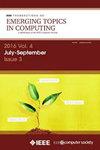QuripfeNet: Quantum-Resistant IPFE-Based Neural Network
IF 5.4
2区 计算机科学
Q1 COMPUTER SCIENCE, INFORMATION SYSTEMS
IEEE Transactions on Emerging Topics in Computing
Pub Date : 2024-10-14
DOI:10.1109/TETC.2024.3479193
引用次数: 0
Abstract
In order to protect the sensitive information in many applications involving neural networks, several privacy-preserving neural networks that operate on encrypted data have been developed. Unfortunately, existing encryption-based privacy-preserving neural networks are mainly built on classical cryptography primitives, which are not secure from the threat of quantum computing. In this paper, we propose the first quantum-resistant solution to protect neural network inferences based on an inner-product functional encryption scheme. The selected state-of-the-art functional encryption scheme based on lattice-based cryptography works with integer-type inputs, which is not directly compatible with neural network computations that operate in the floating point domain. We propose a polynomial-based secure convolution layer to allow a neural network to resolve this problem, along with a technique that reduces memory consumption. The proposed solution, named QuripfeNet, was applied in LeNet-5 and evaluated using the MNIST dataset. In a single-threaded implementation (CPU), QuripfeNet took 107.4 seconds for an inference to classify one image, achieving accuracy of 97.85%, which is very close to the unencrypted version. Additionally, the GPU-optimized QuripfeNet took 25.9 seconds to complete the same task, which is improved by 4.15× compared to the CPU version.QuripfeNet:量子抗ipfe神经网络
为了在许多涉及神经网络的应用中保护敏感信息,人们开发了几种基于加密数据的隐私保护神经网络。不幸的是,现有的基于加密的隐私保护神经网络主要建立在经典的密码原语上,这在量子计算的威胁下是不安全的。在本文中,我们提出了第一个基于内积函数加密方案的保护神经网络推理的抗量子解决方案。选择最先进的功能加密方案基于基于格的加密工作与整数型输入,这是不直接兼容的神经网络计算,操作在浮点域。我们提出了一个基于多项式的安全卷积层,允许神经网络解决这个问题,以及一种减少内存消耗的技术。提出的解决方案名为QuripfeNet,已在LeNet-5中应用,并使用MNIST数据集进行了评估。在单线程实现(CPU)中,QuripfeNet对一个图像进行分类的推理耗时107.4秒,准确率达到97.85%,非常接近未加密的版本。此外,gpu优化的QuripfeNet完成同样的任务需要25.9秒,比CPU版本提高了4.15倍。
本文章由计算机程序翻译,如有差异,请以英文原文为准。
求助全文
约1分钟内获得全文
求助全文
来源期刊

IEEE Transactions on Emerging Topics in Computing
Computer Science-Computer Science (miscellaneous)
CiteScore
12.10
自引率
5.10%
发文量
113
期刊介绍:
IEEE Transactions on Emerging Topics in Computing publishes papers on emerging aspects of computer science, computing technology, and computing applications not currently covered by other IEEE Computer Society Transactions. Some examples of emerging topics in computing include: IT for Green, Synthetic and organic computing structures and systems, Advanced analytics, Social/occupational computing, Location-based/client computer systems, Morphic computer design, Electronic game systems, & Health-care IT.
 求助内容:
求助内容: 应助结果提醒方式:
应助结果提醒方式:


